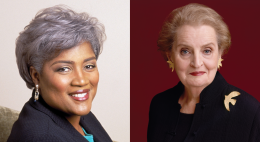
Donna Brazile, left, and Madeleine Albright, right, are among the many politically active professors who come to Georgetown.
Georgetown’s faculty is replete with reputable figures across many fields, but the behind-the-scenes process of acquiring these high-profile professors could constitute a course in its own right.
Many who come have experience with public policy, whether in government or the media. Edward Montgomery, dean of the Georgetown Public Policy Institute, spoke of the ways in which Georgetown’s location facilitates its hiring process.
“Our location here in Washington, D.C., offers a unique opportunity to bring in current and former members of Congress and other top policy practitioners to teach and speak at Georgetown,” Montgomery said.
GPPI in particular attracts prominent public figures such as Paul Begala, a political commentator and former advisor to President Bill Clinton (SFS ’68), and, most recently, former Sen. Richard Lugar (R-Ind.), who will join the faculty as a visiting distinguished professor of public policy in the spring.
“We are constantly searching for top-quality faculty members to join our community at the Georgetown Public Policy Institute,” Montgomery said.
While Montgomery said that high-profile individuals will at times approach the university for positions, School of Foreign Service Dean Carol Lancaster explained that the process of recruiting public figures can be a matter of connections. Often, either university leadership or outsiders with friends who work at Georgetown approach potential faculty to gauge their interest in working at the Hilltop.
“We’re always on the lookout for interesting people who can enrich our offerings to students and faculty, so if somebody else comes along, there might be an opportunity to engage them,” Lancaster said.
Donna Brazile, Al Gore’s campaign manager in his 2000 presidential bid and vice chairwoman of the Democratic National Committee, was approached by the department chair at the time to teach at the university.
Brazile said that after initial conversations with university officials, she was asked to put together a proposal and syllabus.
While there are myriad motivations for notable political figures to take an academic position at Georgetown, many, like Brazile, are passionate about education.
“I carve out one day of my life to spend time on campus,” Brazile, who has been an adjunct professor in the Women and Gender Studies department since 2002, said. “I enjoy teaching — it’s the highlight of my week.”
Others have had previous careers at the university level.
Former Secretary of State Madeleine Albright taught Eastern European studies at Georgetown before joining the Clinton administration. She is currently the Michael and Virginia Mortara Distinguished Professor in the Practice of Diplomacy.
Albright usually teaches “America’s National Security Toolbox” twice a year, devoting a semester each to undergraduates and graduate students.
According to one of her teaching assistants, Peter Billerbeck (GRD ’13), the former secretary is heavily involved in the formation and conduct of the course.
“[Secretary Albright] is really passionate about designing the finer points of the course,” Billerbeck said. “She really does engage with every little thing on the syllabus and has an opinion on everything.”
Lancaster added that some people also enjoy the flexibility academia offers.
“Some of them see having a position at the university as flexible, where they can also write books — like Madeleine Albright has done — or be involved with other boards of organizations or other kinds of things [because] it isn’t a nine to five job or a nine to eight job,” she said. “It gives the individual a lot of flexibility, and I think people coming out of high-profile positions often want that kind of flexibility.”
Other faculty members who have visible name recognition and come to Georgetown do not always have typical professorial responsibilities, however.
“A couple of years ago, we had the former president of Poland [Aleksander Kwasniewski] and the former prime minister of Spain [José Aznar] here, not teaching, but being available to do classes and activities and engage with students,” Lancaster said.
Some, like visiting professor and former Sen. Chuck Hagel (R-Neb.), are only able to spend a few years at Georgetown before moving on to their next occupation.
“Senator Hagel was obviously here and I think very happy here, according to what he’s told me, but, of course, the opportunity to reach for the position of Secretary of Defense has come along,” Lancaster said.
The notable figures also make concerted efforts to spend time with students.
Each semester, Albright holds a weekend-long diplomatic simulation, and Brazile makes sure to maintain her time commitment to her class.
“Last year, the presidential debate was held on one of the nights I taught, [so] I made it up by spending extra time on campus,” Brazile said.
And although politically well-known professors may belong to one party or another, they still support students no matter what their affiliation is.
“I write letters of recommendation for both Republicans and Democrats,” Brazile said.
“I have both Republicans and Democrats as [teaching assistants] and I’m proud of all of them.”








